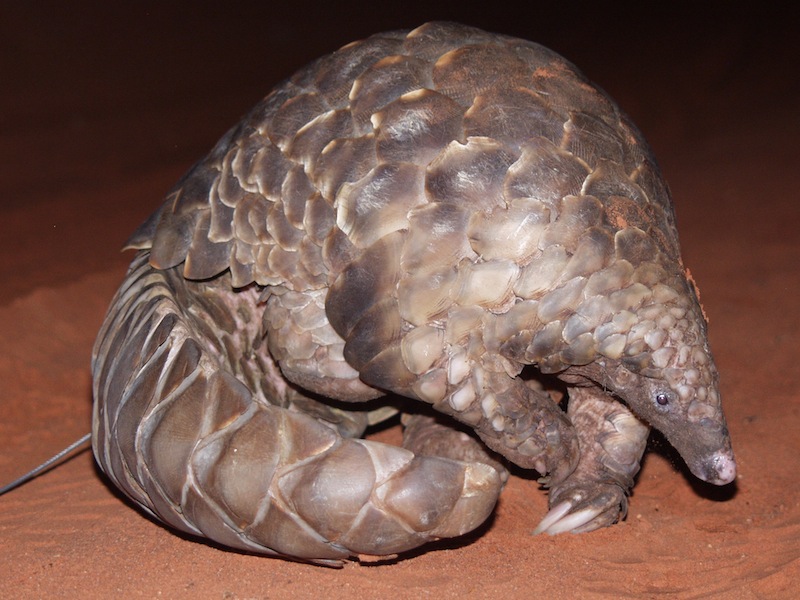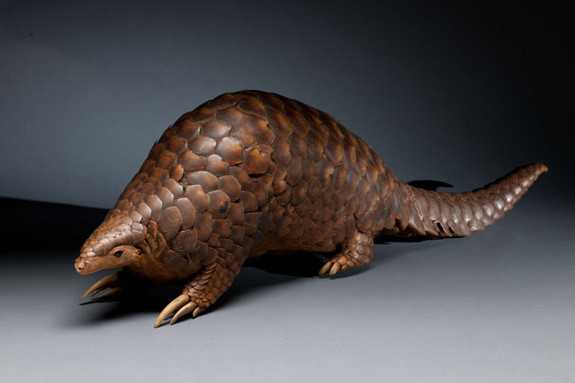Facts About Pangolins

Pangolins are often called scaly anteaters, which is a very good description for them, even though they are not closely related to anteaters. Like anteaters, pangolins have long snouts and even longer tongues that they use to slurp up ants and termites. Their bodies are covered in scales that form a kind of armor.
The scales are made from keratin, the same thing as human hair and fingernails. When threatened, pangolins roll up into a ball. If the other animal gets caught between the scales, it can get a nasty cut. Pangolin is a name derived from the Malay word "pengguling," which means "rolling over."
A pangolin's scales make up 15 percent of its weight, according to the African Wildlife Foundation. These animals have many different colors. They can be a light sandy color, dark brown, olive-brown, pale olive or yellowish-brown. [Pangolin Photos: Scaly Mammals Threatened with Extinction]
Size
There are eight different pangolin species, which vary in size from 12 inches (30.5 centimeters) to 39 inches (99 cm) long. They weigh from about 3.5 lbs. (1.6 kilograms) to 73 lbs. (33 kg), according to the Save Pangolins organization.
Their tongues are quite amazing. When extended, their tongues are longer than their bodies and head combined. Unlike humans and many other animals, the pangolin's tongue is connected not in its mouth, but at the bottom of its ribcage. When not in use, the tongue is stored in the animal's chest cavity.
![The African white-bellied pangolin is the most common pangolin in Africa. Now listed as vulnerable on the IUCN's list of threatened species, the creature is thought to be declining in Ghana and Guinea, and close to extinction in Rwanda. [Read full story]](https://cdn.mos.cms.futurecdn.net/ELX8eW8UWo87sh5bSdjukB.jpg)
Habitat
Pangolins can be found across Asia and sub-Saharan Africa in sandy areas of woodlands and savannas. Their homes, underground burrows, are usually near water sources.
Habits
As nocturnal animals, pangolins spend their days sleeping and their nights foraging for food and digging their burrow. There is very little known about their habits and social activities because they have not been studied extensively.
They have special glands near their anus that secrete a fluid with a pungent odor. They use the fluid to mark their territory, according to Pangolins.org
Diet
These animals are insectivores, which means their diet consists completely of insects. Pangolins don't have teeth. They use their long claws to open up ant and termite hills, then use their sticky tongue to slurp up insects and swallow them whole. Like birds, pangolins swallow small stones. The stones are used to crush and digest food in the stomach.
Offspring
Female pangolins have a gestation period of five months and give birth to just one live baby. At birth, babies, called pangopups, are only about 6 inches (15.24 cm) long and weigh 12 ounces (340 grams), according to the African Wildlife Foundation. Their scales are pink and soft, but start to harden after a day.
Pangolin babies often ride on their mother's tail. When danger is near, the mother will ball herself up around her baby to shield it.
The baby will drink its mother's milk until it is three to four months old and starts eating insects at one month. They reach sexual maturity around when they are 2 years old.

Classification/taxonomy
Here is the classification of pangolins, according to the Integrated Taxonomic Information System:
Kingdom: Animalia Subkingdom: Bilateria Infrakingdom: Deuterostomia Phylum: Chordata Subphylum: Vertebrata Infraphylum: Gnathostomata Superclass: Tetrapoda Class: Mammalia Subclass: Theria Infraclass: Eutheria Order: Pholidota Family: Manidae Genus: Manis
Conservation status
Pangolins are hunted for their meat, which is considered a delicacy in some parts of the world, and for their scales, which are believed to have medicinal qualities. (There is no evidence that they do, according to Pangolins.org.) World Pangolin Day is marked on the third Saturday in February as an opportunity to raise awareness about pangolins and their plight.
According to the World Wildlife Federation, pangolins are one of the most trafficked mammals in Asia and Africa. It is estimated that between the years of 2011 and 2013, 116,990 to 233,980 pangolins were killed. Asian pangolins populations are estimated to have declined by up to 80 percent in the last 10 years.
According to Save Pangolins and confirmed by the International Union for Conservation of Nature's Red List of Threatened Species, all eight species of pangolin are threatened:
Asian pangolins:
- Chinese pangolin (Manis pentadactyla): Critically Endangered
- Sunda pangolin (Manis javanica): Critically Endangered
- Indian pangolin (Manis crassicaudata): Endangered
- Philippine pangolin (Manis culionensis): Endangered
African pangolins:
- Cape or Temminck's Ground pangolin (Smutsia temminckii): Vulnerable
- White-bellied or Tree pangolin (Phataginus tricuspis): Vulnerable
- Giant Ground pangolin (Smutsia gigantea): Vulnerable
- Black-bellied or Long-tailed pangolin (Phataginus tetradactyla): Vulnerable
Additional resources
Sign up for the Live Science daily newsletter now
Get the world’s most fascinating discoveries delivered straight to your inbox.











